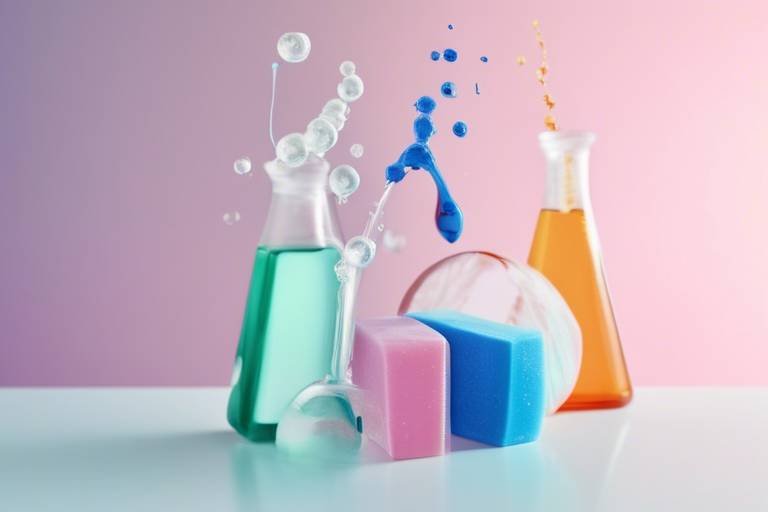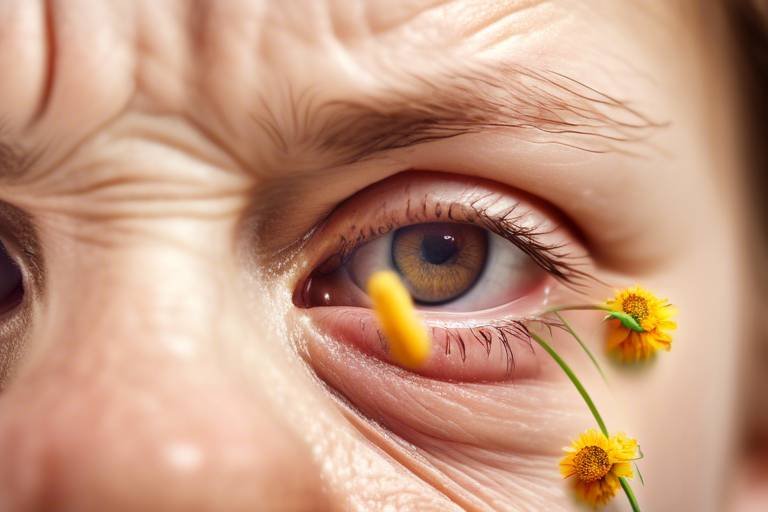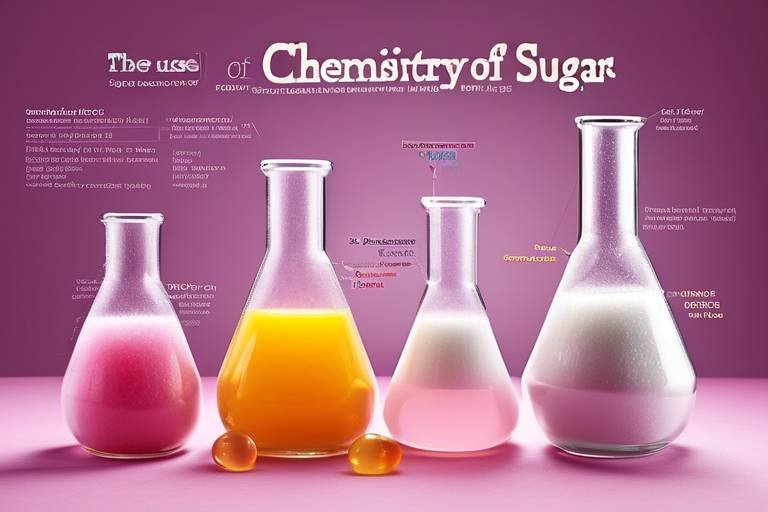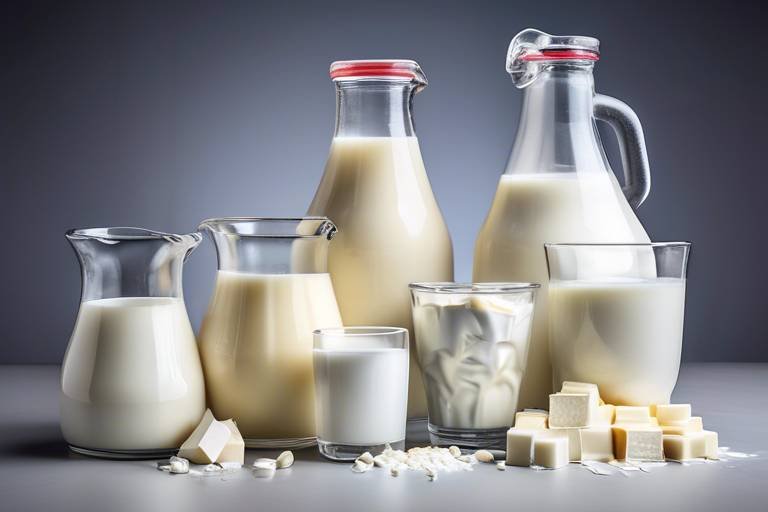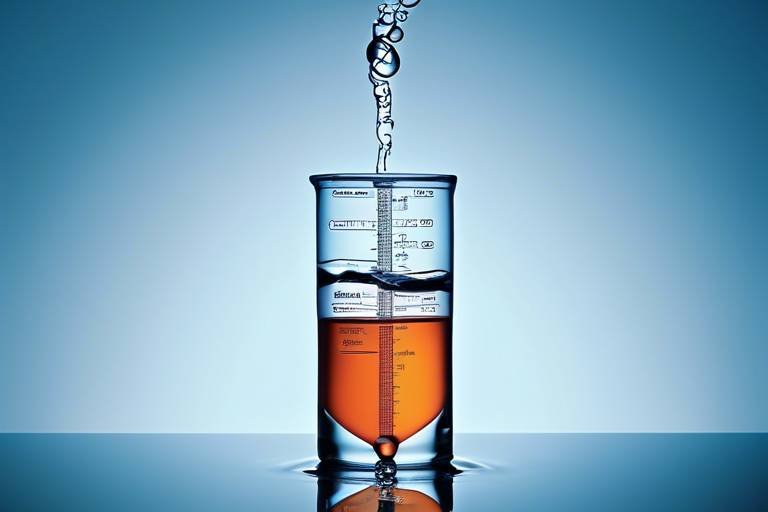The Chemistry of Soap - How It Cleans
Have you ever wondered why soap is so effective at cleaning? It’s not just a simple mixture of ingredients; the chemistry of soap is a fascinating interplay of molecules that work together to tackle dirt, oil, and germs. At its core, soap is a surfactant, which means it has the unique ability to interact with both water and oils. This dual action is what makes soap a powerful cleaning agent. When you lather up with soap, you’re not just spreading a slippery substance; you’re unleashing a chemical reaction that breaks down grime and leaves your skin feeling fresh.
The secret lies in the molecular structure of soap. Each soap molecule has two distinct parts: a hydrophilic (water-attracting) head and a hydrophobic (water-repelling) tail. This unique structure allows soap to effectively bridge the gap between water and oil, which typically do not mix. When you apply soap to a surface, the hydrophobic tails attach themselves to the oil and dirt, while the hydrophilic heads remain in the water. This creates an emulsion, allowing the water to wash away the dirt and oil, demonstrating the remarkable science behind cleaning.
Understanding the molecular composition of soap helps explain its cleaning properties. Soap molecules consist of hydrophilic (water-attracting) and hydrophobic (water-repelling) parts, which play a crucial role in their function. The hydrophilic part is usually made of a carboxylate group, while the hydrophobic part is derived from a long hydrocarbon chain. This dual nature is what makes soap so effective at cleaning. When you mix soap with water, the soap molecules arrange themselves into structures called micelles. In these micelles, the hydrophobic tails cluster together, while the hydrophilic heads face outward into the water. This arrangement allows the soap to encapsulate dirt and oil, effectively lifting them away from surfaces.
Soap cleans by breaking down oils and dirt through a process known as emulsification. When you apply soap and water to a dirty surface, the soap molecules surround the dirt and oil particles. The hydrophobic tails attach to the oil, while the hydrophilic heads remain in the water. This interaction forms tiny droplets of oil suspended in water, which can then be rinsed away. It’s like having a tiny army of soap molecules working tirelessly to lift and remove grime from your skin or any surface. The effectiveness of this process is why soap is a staple in hygiene practices around the world.
Surfactants are key components of soap that reduce surface tension, enabling water to spread and penetrate more effectively. This property enhances soap’s ability to lift and remove dirt. Without surfactants, water would bead up and roll off surfaces, making it much harder to clean. Surfactants allow the water to spread out, reaching every nook and cranny, which is essential for effective cleaning.
Different types of surfactants, such as anionic, cationic, and nonionic, serve various purposes in cleaning products. Each type has unique properties that influence its effectiveness and application. For example:
- Anionic surfactants are negatively charged and are excellent at removing dirt and grease.
- Cationic surfactants are positively charged and often used in fabric softeners and disinfectants.
- Nonionic surfactants do not have a charge and are often used in more gentle cleaning products.
While surfactants are effective cleaning agents, some can be harmful to aquatic ecosystems. Understanding their environmental impact is essential for developing greener cleaning products that minimize ecological harm. Many manufacturers are now focusing on biodegradable surfactants to lessen their footprint on the environment.
While soap effectively removes dirt and germs, antibacterial agents target specific bacteria. This section compares their mechanisms and effectiveness in maintaining hygiene and preventing illness. Soap works by physically removing germs from surfaces, while antibacterial agents kill bacteria directly. However, it’s important to note that soap is often just as effective at preventing illness when used properly.
Soap has a rich history, dating back to ancient civilizations. This section explores its origins, evolution, and how its use has changed over the centuries. From the early days of using animal fats and ashes to modern formulations, soap has come a long way. The art of soap-making has been passed down through generations, evolving with advancements in chemistry and technology.
Traditional soap-making involves saponification, a chemical reaction between fats and an alkali. This process has been practiced for centuries and remains popular among artisans today. Many people appreciate the craftsmanship involved in creating handmade soaps, which often feature natural ingredients and scents.
Advancements in technology have transformed soap production. This section discusses contemporary methods, including industrial processes and the rise of specialty soaps in the market. Today, consumers have access to a wide range of soaps, from luxury bars to eco-friendly liquid soaps, catering to various preferences and needs.
The relationship between soap and skin health is complex. This section examines how different types of soap can affect skin conditions and the importance of choosing the right product. Not all soaps are created equal, and understanding your skin type can help you select the best soap for your needs.
Understanding the differences between moisturizing and cleansing soaps is essential for skincare. Moisturizing soaps contain added oils and fats that help hydrate the skin, while cleansing soaps focus on removing dirt and oil. Depending on your skin type, one may be more beneficial than the other.
Some individuals may experience allergic reactions to certain soap ingredients. This section highlights common allergens and offers tips for selecting hypoallergenic products. It’s crucial to read labels and choose products that are gentle on the skin, especially for those with sensitive skin or allergies.
1. What is the main ingredient in soap?
Soap is primarily made from fats or oils combined with an alkali, typically sodium hydroxide or potassium hydroxide.
2. Can soap kill germs?
Soap effectively removes dirt and germs from surfaces, but it does not kill bacteria in the same way that antibacterial agents do.
3. Is handmade soap better than commercial soap?
Handmade soap often contains natural ingredients and fewer chemicals, making it a popular choice for those with sensitive skin.
4. How do I choose the right soap for my skin type?
Consider your skin type and any specific concerns, such as dryness or sensitivity, when selecting a soap. Moisturizing soaps are better for dry skin, while cleansing soaps can be beneficial for oily skin.

The Structure of Soap
Understanding the molecular composition of soap is like peering into a fascinating world where chemistry meets everyday life. Soap molecules are unique in that they possess both a hydrophilic (water-attracting) head and a hydrophobic (water-repelling) tail. This dual nature is what makes soap such an effective cleaning agent. Imagine a tiny soldier with two distinct personalities: one that loves to be in water and another that shuns it. This is the essence of soap's structure, and it plays a crucial role in how soap interacts with dirt and oil.
At the heart of soap's effectiveness lies its amphiphilic structure. The hydrophilic head, which is typically made of a carboxylate group, is attracted to water molecules, while the hydrophobic tail, composed of long hydrocarbon chains, repels water but is attracted to oils and grease. When you use soap, these molecules work together to form structures called micelles. A micelle is like a tiny bubble with a water-loving exterior and a grease-loving interior. The hydrophobic tails gather around the dirt and oil, trapping them in the center, while the hydrophilic heads remain in the water, allowing the entire structure to be washed away. This is the magic of emulsification!
To visualize this, consider the following table that summarizes the components of soap molecules:
| Component | Function |
|---|---|
| Hydrophilic Head | Attracts water, allowing soap to dissolve in water. |
| Hydrophobic Tail | Attracts oils and grease, enabling dirt to be lifted away. |
| Micelle Formation | Encapsulates dirt and oil, making them easier to rinse away. |
This unique structure not only allows soap to clean effectively but also demonstrates why different types of soap can have varying cleaning abilities. For example, some soaps are designed with additional ingredients that enhance their performance, such as moisturizers for skin care or fragrances for a pleasant scent. However, it’s essential to choose the right soap based on your specific needs, as not all soaps are created equal. Some may be more suitable for sensitive skin, while others may be better for heavy-duty cleaning tasks.
In conclusion, the structure of soap is a brilliant example of nature's ingenuity. Its ability to bridge the gap between water and oil makes it an indispensable tool in our daily hygiene practices. Next time you wash your hands or clean your dishes, remember the little soap molecules working hard to keep your world clean!

How Soap Cleans
Soap is not just a pretty bar or a bubbly liquid; it’s a remarkable concoction of chemistry that works wonders in our daily lives. At its core, soap cleans through a fascinating process known as emulsification. But what exactly does that mean? Imagine trying to wash a greasy pan with just water. It’s nearly impossible, right? The oil and dirt simply float around, refusing to budge. This is where soap steps in like a superhero, ready to save the day!
Soap molecules have a unique structure that allows them to interact with both water and oil. Each soap molecule has two distinct parts: a hydrophilic (water-attracting) head and a hydrophobic (water-repelling) tail. When you mix soap with water, the hydrophilic heads are drawn to the water while the hydrophobic tails cling to the grease and dirt. This dual nature is what makes soap so effective. It’s like having a friend who can navigate both the water and the oil worlds!
When you apply soap to a dirty surface, the soap molecules surround the dirt and oil particles, forming tiny clusters called micelles. The hydrophobic tails of the soap molecules attach themselves to the oil and dirt, while the hydrophilic heads remain in the water. This creates a sort of bubble that traps the unwanted substances. When you rinse with water, these micelles are washed away, taking the grime with them. It’s like a tiny cleaning army marching away with all the dirt!
To give you a clearer picture, here’s a simple diagram of how soap works:
| Step | Description |
|---|---|
| 1 | Soap is applied to a surface with dirt or oil. |
| 2 | Soap molecules surround the dirt and oil, forming micelles. |
| 3 | Rinsing with water washes away the micelles, leaving the surface clean. |
This process of emulsification is crucial not only for cleaning surfaces but also for maintaining hygiene. By breaking down oils and dirt, soap ensures that bacteria and viruses are effectively removed from our skin and other surfaces. In a world where cleanliness is paramount, the chemistry of soap plays an essential role in our health.
Moreover, the effectiveness of soap is further enhanced by the presence of surfactants. These are compounds that lower the surface tension of water, allowing it to spread and penetrate more effectively. Surfactants are the unsung heroes that help soap do its job better. They help lift dirt and oil away from surfaces, making it easier for water to wash them away. Without surfactants, soap wouldn’t be nearly as effective as it is today!
So, the next time you lather up, take a moment to appreciate the incredible science behind that simple bar of soap. It’s not just about getting clean; it’s about understanding how a little chemistry can make a big difference in our daily lives!
- How does soap remove bacteria? Soap removes bacteria by breaking down the oils and dirt that harbor germs, allowing them to be rinsed away with water.
- Can soap work without water? No, water is essential for soap to create the micelles that trap and wash away dirt and bacteria.
- Are all soaps the same? No, different soaps have different formulations and surfactants, which can affect their cleaning effectiveness.

The Role of Surfactants
Surfactants, short for surface-active agents, play a pivotal role in the cleaning process of soap. These remarkable molecules are designed to reduce the surface tension of water, allowing it to spread and penetrate surfaces more effectively. Imagine trying to wash a greasy pan with plain water; it would be a frustrating experience, right? This is where surfactants come into play, acting like tiny superheroes that break down barriers between water and dirt.
When soap is mixed with water, surfactants align themselves at the interface between the water and oil or dirt. Their unique structure consists of a hydrophilic (water-attracting) head and a hydrophobic (water-repelling) tail. This dual nature allows surfactants to attach to both water and oil, creating a bridge that facilitates the removal of grime. The hydrophobic tails latch onto the dirt and oil, while the hydrophilic heads remain in the water, effectively emulsifying the unwanted substances.
During this process, surfactants form structures known as micelles. A micelle is a spherical arrangement where the hydrophobic tails cluster together in the center, trapping oil and dirt, while the hydrophilic heads face outward, interacting with water. This formation is crucial for lifting dirt away from surfaces and allowing it to be rinsed away easily. Without surfactants, cleaning would be a much more laborious task, akin to trying to remove a stubborn stain with only a dry cloth.
Let’s delve a bit deeper into the types of surfactants commonly found in soap:
| Type of Surfactant | Characteristics | Common Uses |
|---|---|---|
| Anionic | Negatively charged, excellent for removing dirt and grease | Household cleaners, laundry detergents |
| Cationic | Positively charged, effective against bacteria | Fabric softeners, disinfectants |
| Nonionic | Neutral charge, gentle on skin, versatile | Baby soaps, mild cleaning products |
Each type of surfactant has its own unique properties that influence how well it performs in different cleaning scenarios. For instance, anionic surfactants are often used in laundry detergents due to their strong dirt-lifting capabilities, while nonionic surfactants are preferred in products designed for sensitive skin.
However, while surfactants are essential for effective cleaning, it's important to be aware of their potential environmental impact. Some surfactants can be harmful to aquatic life, leading to a growing demand for greener alternatives. This awareness is crucial for consumers who want to make informed choices about the cleaning products they use.
In summary, surfactants are the unsung heroes of soap, working tirelessly behind the scenes to ensure that we can enjoy clean surfaces and fresh-smelling laundry. Their ability to bridge the gap between water and oil makes them indispensable in our daily cleaning routines.

Types of Surfactants
When it comes to soap and cleaning products, surfactants are the unsung heroes that make everything work. But did you know that not all surfactants are created equal? In fact, there are several types of surfactants, each with its own unique set of properties and applications. Understanding these differences can help you choose the right product for your cleaning needs.
Surfactants can be broadly classified into three main categories: anionic, cationic, and nonionic surfactants. Each type has its own characteristics that make it suitable for specific tasks.
| Type of Surfactant | Charge | Common Uses |
|---|---|---|
| Anionic | Negative | Household cleaners, laundry detergents |
| Cationic | Positive | Fabric softeners, disinfectants |
| Nonionic | Neutral | Dishwashing liquids, mild cleansers |
Anionic surfactants are perhaps the most commonly used type. They are highly effective at removing dirt and grease due to their negative charge, which helps them attach to positively charged dirt particles. This makes them excellent for use in household cleaners and laundry detergents. However, they can sometimes be harsh on the skin, so it's important to use them judiciously.
On the other hand, cationic surfactants carry a positive charge and are primarily used in products like fabric softeners and disinfectants. Their positive charge allows them to bond with negatively charged surfaces, which is why they are effective at reducing static cling in fabrics. However, they may not be as effective at cleaning as anionic surfactants, making them more suitable for specific applications.
Finally, we have nonionic surfactants, which are neutral and can be used in a variety of cleaning products, including dishwashing liquids and mild cleansers. Their gentle nature makes them ideal for use on sensitive skin, and they are often found in products designed for children or individuals with skin sensitivities. Nonionic surfactants are also effective in hard water, which is a significant advantage in many cleaning scenarios.
In summary, the type of surfactant used in a cleaning product can significantly affect its performance and suitability for various applications. Whether you're tackling tough grease stains or looking for a gentle soap for your skin, understanding the differences between anionic, cationic, and nonionic surfactants can help you make informed choices.
- What are surfactants? Surfactants are compounds that lower the surface tension between two substances, such as oil and water, making them effective in cleaning products.
- Are all surfactants safe for skin? Not all surfactants are suitable for all skin types. It’s essential to choose products that contain gentle surfactants if you have sensitive skin.
- Can I make soap at home using surfactants? Yes, you can create your own soap using surfactants, but it requires careful measurement and understanding of the chemical reactions involved.
- What is the environmental impact of surfactants? Some surfactants can harm aquatic life, so it's crucial to choose biodegradable options when possible.

Environmental Impact of Surfactants
Surfactants, while essential in the cleaning process, carry significant environmental implications that cannot be overlooked. These compounds, designed to break down oils and dirt, can have adverse effects on aquatic ecosystems when they enter waterways. The dual nature of surfactants—hydrophilic and hydrophobic—enables them to interact with both water and oils, but this same property can lead to environmental challenges. When surfactants are washed away, they can disrupt the natural balance of aquatic environments, harming organisms that rely on clean water.
One of the primary concerns is the toxicity of certain surfactants to marine life. For instance, anionic surfactants, commonly found in many household cleaning products, can be particularly harmful to fish and other aquatic organisms. When these substances accumulate in rivers and oceans, they can lead to a phenomenon known as eutrophication, where excess nutrients promote the overgrowth of algae. This growth depletes oxygen levels in the water, resulting in dead zones where aquatic life cannot survive.
Moreover, some surfactants are not readily biodegradable, meaning they persist in the environment for extended periods. This persistence raises concerns about bioaccumulation, where toxic substances accumulate in the tissues of organisms, potentially moving up the food chain and affecting human health. To mitigate these impacts, it is crucial for consumers to be aware of the products they choose and for manufacturers to adopt greener formulations.
In response to these environmental challenges, there has been a growing movement towards the use of biodegradable surfactants. These alternatives are designed to break down more easily in the environment, reducing the risk of toxicity and accumulation. Additionally, many companies are now focused on developing eco-friendly cleaning products that utilize natural ingredients with minimal environmental impact.
To summarize, the environmental impact of surfactants is a complex issue that requires careful consideration. Understanding the balance between effective cleaning and ecological responsibility is essential for promoting sustainable practices in both households and industries. As consumers, we can make informed choices by selecting products that prioritize environmental health, thus contributing to a cleaner planet.
- What are surfactants? Surfactants are compounds that lower the surface tension between two substances, such as oil and water, making them effective in cleaning products.
- Why are some surfactants harmful to the environment? Certain surfactants can be toxic to aquatic life and may persist in the environment, leading to bioaccumulation and ecological disruption.
- How can I choose environmentally friendly cleaning products? Look for products labeled as biodegradable, eco-friendly, or made with natural ingredients to minimize environmental impact.
- What is eutrophication? Eutrophication is the excessive growth of algae in water bodies due to nutrient overload, often caused by pollutants such as surfactants, leading to oxygen depletion.
- Are there safer alternatives to traditional surfactants? Yes, many companies are developing biodegradable surfactants that are less harmful to the environment and still effective for cleaning.

Soap vs. Antibacterial Agents
When it comes to keeping our hands clean and preventing illness, the debate between soap and antibacterial agents often arises. Many people believe that using antibacterial products is the best way to combat germs, but the reality is a bit more nuanced. Soap is a time-tested method that not only cleans but also removes dirt and bacteria effectively. Its primary mechanism is based on the principle of emulsification, which means it helps to lift and wash away grime when mixed with water.
On the other hand, antibacterial agents, often found in specialized soaps and hand sanitizers, are designed to target specific bacteria. These agents work by disrupting the cellular processes of bacteria, effectively killing them on contact. However, the effectiveness of these agents can vary depending on the type of bacteria and the concentration of the antibacterial ingredient. It's essential to understand that while antibacterial products can be beneficial in certain situations, they are not always necessary for everyday use.
To illustrate the differences between soap and antibacterial agents, consider the following:
| Feature | Soap | Antibacterial Agents |
|---|---|---|
| Mechanism of Action | Emulsifies dirt and oil, allowing them to be rinsed away | Kills or inhibits the growth of specific bacteria |
| Broad Spectrum | Effective against a wide range of dirt, oils, and bacteria | Targets specific bacteria, not all germs |
| Skin Health | Generally gentle; can be moisturizing | Can cause skin irritation with overuse |
| Environmental Impact | Biodegradable, depending on ingredients | Some may be harmful to aquatic life |
In many everyday situations, such as washing hands after using the restroom or before eating, regular soap is more than sufficient for maintaining hygiene. It effectively removes germs and dirt without the potential drawbacks associated with overusing antibacterial products. Over time, frequent use of antibacterial agents can lead to the development of resistant bacteria, making them less effective.
So, when should you reach for antibacterial soap? In situations where you are exposed to higher risks of infection, such as during a pandemic or when caring for someone who is ill, using an antibacterial agent can provide an added layer of protection. However, for routine handwashing, regular soap is typically the best choice. Remember, the key to effective cleaning is not just the type of product used, but also the technique—lathering for at least 20 seconds and rinsing thoroughly is crucial.
Ultimately, both soap and antibacterial agents have their place in our hygiene toolkit. Understanding the differences can help you make informed choices that best suit your needs and promote overall health.
- Can I use antibacterial soap instead of regular soap? Yes, but it's often not necessary for everyday use. Regular soap is effective at removing dirt and germs.
- Are antibacterial soaps better at preventing illness? Not necessarily. Regular handwashing with soap and water is typically sufficient for most situations.
- Can I use soap and antibacterial products together? While it's generally safe, it's best to use one or the other based on your needs to avoid skin irritation.
- What should I look for in a soap? Look for ingredients that suit your skin type, and consider whether you need moisturizing or cleansing properties.

The History of Soap
The history of soap is a fascinating journey that traces back to ancient civilizations, showcasing how this simple yet essential product has evolved over the centuries. The earliest records of soap-making date back to around 2800 BC in ancient Babylon, where a mixture of fats and ashes was used for cleaning purposes. These early soaps were not as refined as modern products, but they laid the groundwork for what would become a vital aspect of hygiene and cleanliness.
In ancient Egypt, soap was made from a combination of animal and vegetable oils mixed with alkaline salts. This mixture was used not only for washing but also for medicinal purposes. The Egyptians recognized the importance of cleanliness and often associated it with health and well-being. Interestingly, they even used soap in their embalming processes, highlighting its significance in their culture.
As we move through history, we find that the Romans also played a crucial role in the evolution of soap. They created a soap-like substance made from animal fats and wood ash, which they used in their public baths. The Romans valued bathing as a social activity, and their use of soap helped to promote cleanliness among the masses. However, it wasn't until the Middle Ages that soap-making began to flourish in Europe, particularly in places like France and Italy.
During this period, soap was often made using the saponification process, where fats were combined with lye (sodium hydroxide). This method produced a more effective cleaning product and led to the establishment of soap as a significant industry. By the 16th century, soap was being produced in various forms, including solid bars and liquid soaps, catering to different cleaning needs.
Fast forward to the 19th century, when the Industrial Revolution brought about significant advancements in soap production. The introduction of new manufacturing techniques and the availability of synthetic ingredients allowed for mass production. This era saw the emergence of well-known soap brands that are still popular today. The ability to produce soap on a large scale made it accessible to a broader audience, transforming it from a luxury item into a household staple.
Today, soap continues to evolve, with a growing emphasis on natural and organic ingredients. The rise of specialty soaps, such as artisanal and handmade varieties, reflects a shift in consumer preferences towards products that are not only effective but also environmentally friendly. The history of soap is a testament to human ingenuity and our enduring quest for cleanliness.
- When was soap first invented? The earliest known use of soap dates back to around 2800 BC in ancient Babylon.
- What were the original ingredients in soap? Early soaps were made from a mixture of fats and ashes, and later with animal and vegetable oils combined with alkaline salts.
- How did soap evolve during the Middle Ages? The saponification process became popular, leading to the production of more effective cleaning products.
- What impact did the Industrial Revolution have on soap production? It allowed for mass production of soap, making it widely accessible and affordable for the general public.
- What is the trend in soap-making today? There is a growing demand for natural and organic soaps, with many consumers seeking environmentally friendly options.

Traditional Soap-Making Methods
Traditionally, soap-making has been an art passed down through generations, deeply rooted in the chemistry of saponification. This fascinating process involves a chemical reaction between fats or oils and an alkali, typically sodium hydroxide for solid soaps or potassium hydroxide for liquid soaps. Imagine mixing two seemingly unrelated substances, like oil and water, and watching them transform into something entirely new and useful! This transformation not only creates soap but also illustrates the power of chemistry in our daily lives.
Historically, soap-making began with the ancient Babylonians around 2800 B.C., who used a mixture of animal fats and wood ash to create a rudimentary form of soap. Over the centuries, various cultures refined these methods, incorporating local resources and techniques. For example, the Romans added fragrances to their soaps, while the Egyptians were known for using oils and natural ingredients to enhance their cleansing rituals.
The traditional soap-making process can be broken down into several key steps:
- Preparation of Ingredients: This step involves selecting high-quality fats or oils, such as olive oil, coconut oil, or palm oil, and mixing them with an alkali solution. The purity of these ingredients significantly influences the final product.
- Saponification: This is the heart of the soap-making process. When the fats and alkali are combined, they undergo a reaction that produces glycerin and soap. This reaction can take anywhere from a few hours to several days, depending on the method used.
- Curing: After saponification, the soap must be cured for several weeks. This allows excess water to evaporate and the soap to harden, resulting in a longer-lasting product. During this time, the soap's pH levels also stabilize, making it safer for skin contact.
- Cutting and Molding: Once cured, the soap is cut into bars or molded into various shapes. This is where creativity can shine, as artisans often add colors, scents, and textures to their creations.
One of the most cherished aspects of traditional soap-making is the ability to customize the product. Artisans often experiment with different oils, essential oils, and natural additives like herbs or clays to create unique soaps tailored to specific skin types or preferences. For instance, a soap made with oatmeal can provide gentle exfoliation, while a lavender-infused soap can offer calming aromatherapy benefits.
In recent years, there has been a resurgence of interest in traditional soap-making, as more people seek natural, handmade alternatives to commercial products laden with synthetic ingredients. This movement not only promotes sustainability but also encourages a deeper connection with the products we use on our bodies. The traditional methods of soap-making remind us of the beauty and complexity of nature, transforming simple ingredients into nourishing and cleansing treasures.
As we delve deeper into the world of soap, it’s essential to appreciate the craftsmanship and knowledge that go into traditional methods. These age-old techniques not only produce effective cleaning agents but also foster a sense of community and creativity among soap makers. So, the next time you lather up, take a moment to reflect on the rich history and science that makes your soap so special!
1. What is saponification?
Saponification is the chemical reaction that occurs when fats or oils are combined with an alkali, resulting in the formation of soap and glycerin.
2. Can I make soap at home?
Yes! Many people enjoy making soap at home using traditional methods. There are numerous resources and kits available to help you get started safely.
3. What types of oils are best for soap-making?
Common oils used in soap-making include olive oil, coconut oil, and palm oil. Each oil contributes unique properties to the soap, such as lather, moisturizing abilities, and hardness.
4. How long does homemade soap need to cure?
Homemade soap typically requires a curing time of 4 to 6 weeks to ensure it hardens properly and is safe for skin use.
5. Are there any allergens in soap?
Yes, some individuals may be allergic to certain ingredients in soap, such as fragrances or specific oils. It’s essential to read labels and choose hypoallergenic options if you have sensitivities.

Modern Soap Production
In today’s fast-paced world, the production of soap has undergone significant transformations, thanks to advancements in technology and a growing understanding of chemistry. Modern soap production is not just about mixing fats and alkalis; it’s a sophisticated process that combines science, art, and environmental awareness. The evolution of manufacturing techniques has led to the creation of a wide array of soap products tailored to meet diverse consumer needs.
One of the most notable changes in modern soap production is the shift towards industrial processes. Automated systems allow for large-scale production, ensuring consistency and quality across batches. These systems utilize precise measurements and controlled environments to achieve the perfect saponification reaction. The result? A product that not only cleans but also meets stringent safety and quality standards.
Moreover, the rise of specialty soaps has transformed the market. Consumers are no longer satisfied with generic bars of soap; they seek products that cater to specific preferences and skin types. This demand has led to the development of a variety of soaps, including:
- Organic soaps: Made from natural ingredients, free from synthetic chemicals.
- Glycerin soaps: Known for their moisturizing properties, ideal for dry skin.
- Antibacterial soaps: Formulated to target and eliminate germs effectively.
- Artisanal soaps: Handcrafted soaps that often incorporate unique scents and textures.
In addition to product variety, modern soap production emphasizes sustainability. Manufacturers are increasingly aware of their environmental impact and are adopting greener practices. This includes sourcing sustainable raw materials, reducing waste during production, and using eco-friendly packaging. For instance, some companies are exploring biodegradable surfactants as alternatives to traditional ones that may harm aquatic ecosystems.
Furthermore, the advent of online shopping has revolutionized how consumers access soap products. E-commerce platforms allow small businesses to reach a broader audience, showcasing their unique creations and catering to niche markets. This accessibility has fostered a community of soap enthusiasts who appreciate the artistry and craftsmanship behind each bar.
To summarize, modern soap production is a dynamic field that blends technology, creativity, and environmental consciousness. As consumers continue to seek out products that align with their values and needs, the soap industry will undoubtedly keep evolving, pushing the boundaries of what soap can be. Whether you're a fan of traditional bars or the latest artisanal creations, there’s no denying that the journey of soap from raw materials to your hands is a fascinating one!
Here are some common questions about modern soap production:
- What ingredients are commonly used in modern soap production? Modern soaps often contain fats (like vegetable oils), alkalis (such as sodium hydroxide), and various additives for fragrance, color, and skin benefits.
- How can I choose the right soap for my skin type? Consider your skin's needs—if you have dry skin, look for moisturizing soaps; for oily skin, opt for cleansing soaps that help control oil.
- Are artisanal soaps better than commercial soaps? It depends on personal preference. Artisanal soaps often use natural ingredients and are handcrafted, which some people prefer for their unique qualities.
- What should I look for in eco-friendly soap? Look for labels that indicate biodegradable ingredients, sustainable sourcing, and minimal packaging.

Soap and Skin Care
The relationship between soap and skin health is incredibly intricate and multifaceted. On one hand, soap is essential for maintaining personal hygiene and preventing the spread of bacteria and viruses. On the other hand, the type of soap you choose can significantly impact your skin's health and appearance. For instance, some soaps are formulated with harsh chemicals that can strip the skin of its natural oils, leading to dryness and irritation. In contrast, others are enriched with moisturizing ingredients that can nourish and hydrate the skin. This duality makes it crucial to understand the different types of soaps available and how they interact with various skin types.
When selecting a soap, it’s important to consider your skin type. For example, individuals with oily skin may benefit from soaps that contain ingredients like salicylic acid, which can help control excess oil and prevent breakouts. Conversely, those with dry or sensitive skin might prefer moisturizing soaps that include natural oils or glycerin, which can help lock in moisture and soothe irritation. Additionally, soaps with added fragrances or dyes may cause allergic reactions in some individuals, making it essential to read labels carefully.
Furthermore, the pH level of soap plays a significant role in its effects on the skin. Traditional soaps tend to have a higher pH, which can disrupt the skin's natural acid mantle—a barrier that protects against harmful bacteria and environmental stressors. This disruption can lead to conditions such as eczema or psoriasis in susceptible individuals. Therefore, opting for pH-balanced soaps can be a wise choice for maintaining healthy skin.
In recent years, there has been a growing trend towards using natural and organic soaps. These products often contain fewer synthetic ingredients and more plant-based components, appealing to those looking for gentler alternatives. However, it’s important to note that “natural” doesn’t always mean “better.” Some natural ingredients can still cause irritation, so it’s wise to patch-test new products before fully incorporating them into your skincare routine.
In summary, understanding the connection between soap and skin care is vital for making informed choices. The right soap can enhance your skin's health, while the wrong one can lead to a myriad of problems. Always consider your skin's unique needs and choose products that align with those requirements.
- What type of soap is best for sensitive skin?
Look for hypoallergenic soaps that are free from fragrances and dyes. - Can soap cause skin allergies?
Yes, certain ingredients in soap can trigger allergic reactions in some individuals. - Is antibacterial soap better than regular soap?
While antibacterial soap can kill germs, regular soap is effective at removing dirt and bacteria when used properly. - How often should I wash my hands with soap?
It's recommended to wash your hands with soap for at least 20 seconds, especially after being in public places.

Moisturizing vs. Cleansing Soaps
When it comes to choosing the right soap, understanding the difference between moisturizing and cleansing soaps is crucial. Each type serves a unique purpose, and recognizing how they work can significantly impact your skin health. Moisturizing soaps are formulated with ingredients that help retain moisture in your skin, making them ideal for those with dry or sensitive skin. These soaps often contain emollients—substances that soften and soothe the skin—such as glycerin, shea butter, or oils. On the other hand, cleansing soaps are designed to remove dirt, oil, and impurities from the skin. They typically contain stronger surfactants that create a rich lather, effectively washing away grime but sometimes stripping the skin of its natural oils.
So, how do you choose the right soap for your skin type? It’s all about understanding your skin's needs. If you have oily skin, a cleansing soap might be beneficial, as it can help control excess oil and prevent breakouts. However, if your skin tends to be dry or sensitive, you might want to lean towards moisturizing soaps that provide hydration and prevent irritation. Here’s a quick comparison of the two:
| Feature | Moisturizing Soaps | Cleansing Soaps |
|---|---|---|
| Purpose | Retain moisture | Remove dirt and oil |
| Common Ingredients | Glycerin, oils, shea butter | Sodium lauryl sulfate, other surfactants |
| Best For | Dry or sensitive skin | Oily or acne-prone skin |
It’s also worth noting that some soaps combine both properties, offering a balance of cleansing power while still providing moisture. These hybrid soaps can be a great option for individuals with combination skin, allowing for effective cleaning without compromising hydration. However, it’s essential to read the labels carefully. Look for terms like “hydrating” or “moisturizing” to ensure you’re getting the benefits you seek.
Ultimately, the choice between moisturizing and cleansing soaps boils down to personal preference and skin type. It’s a bit like choosing between a refreshing drink of water and a rich, creamy smoothie. Both can be satisfying, but knowing your body’s needs will help you make the right choice. So next time you’re browsing the soap aisle, remember to consider what your skin truly craves!
- Can I use cleansing soap on dry skin? While it’s possible, it may exacerbate dryness. It’s better to opt for moisturizing soaps.
- Are moisturizing soaps less effective at cleaning? Not necessarily! They can effectively clean while also hydrating the skin.
- How often should I wash my skin with soap? It depends on your skin type, but generally, once or twice a day is sufficient.

Allergies and Sensitivities
When it comes to soap, not all products are created equal, and for some individuals, certain ingredients can trigger allergic reactions or sensitivities. These reactions can range from mild irritations to more severe responses, making it crucial to understand what goes into your favorite cleansing products. Many soaps contain fragrances, preservatives, and colorants, which, while enhancing the product's appeal, can also be culprits behind skin issues. Have you ever wondered why your skin feels itchy or develops a rash after using a particular soap? You might be one of the many people who are sensitive to common soap ingredients.
Common allergens found in soaps include:
- Fragrance: This is perhaps the most prevalent irritant. Many soaps boast delightful scents, but these fragrances can be synthetic and may cause reactions in sensitive individuals.
- Preservatives: Ingredients like parabens and formaldehyde-releasing agents are often used to prolong shelf life, but they can also lead to skin irritation.
- Colorants: Artificial dyes can make a soap visually appealing, but they can also trigger allergic responses in some people.
- Essential Oils: While natural, some essential oils can be potent irritants and may cause reactions in individuals with sensitive skin.
It's essential to read the labels carefully and opt for products labeled as hypoallergenic or specifically formulated for sensitive skin. These products are usually free from common irritants and are designed to minimize the risk of allergic reactions. However, keep in mind that "hypoallergenic" does not mean completely free from allergens; it simply means that the product is less likely to cause a reaction.
If you suspect you have a sensitivity to a particular soap, consider performing a patch test before fully committing to a new product. Apply a small amount of the soap to a discreet area of skin, such as your inner forearm, and wait 24-48 hours to see if any reaction occurs. This simple test can save you from a potential skin disaster!
In summary, understanding the ingredients in your soap is vital for maintaining healthy skin. By being informed and cautious, you can navigate the world of soaps and find products that clean effectively without causing discomfort or irritation.
1. What are the signs of a soap allergy?
Common signs include redness, itching, burning, or rashes on the skin after using a soap product. If you experience these symptoms, consider switching to a different product.
2. Can I use natural soaps if I have sensitive skin?
Natural soaps can be a great option, but they may still contain ingredients that could irritate sensitive skin. Always check the ingredient list and perform a patch test.
3. Are there any specific ingredients I should avoid?
Yes, avoid soaps with synthetic fragrances, parabens, and harsh detergents. Look for products that are labeled as free from these common irritants.
4. What is the best type of soap for sensitive skin?
Look for gentle, fragrance-free soaps that are specifically labeled for sensitive skin or hypoallergenic. These products are formulated to minimize irritation.
Frequently Asked Questions
- What is the chemical structure of soap?
Soap is made up of molecules that have two distinct parts: a hydrophilic (water-attracting) head and a hydrophobic (water-repelling) tail. This unique structure allows soap to interact with both water and oils, making it effective in cleaning.
- How does soap actually clean surfaces?
Soap cleans by a process called emulsification, where the hydrophobic tails of soap molecules attach to dirt and oil, while the hydrophilic heads remain in the water. This interaction allows the dirt to be lifted away and rinsed off with water.
- What are surfactants and why are they important?
Surfactants are key ingredients in soap that reduce surface tension, enabling water to spread and penetrate surfaces more effectively. This property enhances the soap's ability to lift and remove dirt and grime.
- Are all surfactants safe for the environment?
Not all surfactants are environmentally friendly. Some can be harmful to aquatic ecosystems, which is why it's important to choose cleaning products that use biodegradable and eco-friendly surfactants.
- How does soap differ from antibacterial agents?
While soap effectively removes dirt and germs through physical action, antibacterial agents specifically target and kill bacteria. Both play important roles in hygiene, but they work in different ways.
- What is the history behind soap-making?
Soap has a fascinating history that dates back to ancient civilizations. Traditionally, soap was made through a process called saponification, which involves a chemical reaction between fats and an alkali.
- What are the differences between moisturizing and cleansing soaps?
Moisturizing soaps are designed to hydrate the skin, often containing ingredients like glycerin or oils, while cleansing soaps focus on removing dirt and oil. Choosing the right type depends on your skin needs.
- Can people have allergic reactions to soap?
Yes, some individuals may experience allergic reactions to certain ingredients in soap. It's essential to look for hypoallergenic products, especially if you have sensitive skin or known allergies.

